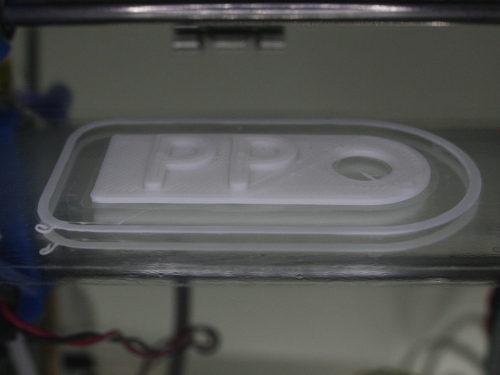I recently purchased a small sample of white polypropylene (PP) plastic from a shop in China.
While it was relatively expensive at ~$11 for 200g worth of plastic it allowed me to try out printing in PP without buying an entire spool of filament.
And since it isn’t supposed to be the easiest thing to print due to a thermal contraction that should make it more warp prone than ABS and additionally is slightly slippery and doesn’t stick that well to other materials.
You may then ask why I would want to attempt to print in PP then, after all PLA prints just fine… well sort of anyway.
Polypropylene is/has the following features:
- Relatively heat resistant, plastic handles on dishwasher safe cutlery are for instance often made of it.
- Good chemical resistance.
- Handles bending and flexing relatively well, living hinges can be made of it.
- Is relatively soft, not always a good thing.
Well back to the printing business…
For the experiments I used my trusty RepRapPro Huxley with a smaller 0.3mm nozzle more on that later.
Yes I really should get that Mendle90 build, that would have allowed me to borrow some 3mm PP welding rod from work.
Anyway I’m by far not the first to print in polypropylene, but as with NinjaFlex I though it could use another post on the internet about the material.(Some links to “prior art”: RapMan wiki and a forum post)
While it seemed that PP and especially HDPE are good candidates for the print bed I had to try out polyimide and some generic blue masking tape as well.
As I expected they didn’t seem to work too well for me. But didn’t experiment too much with them.
I there for proceeded and bought some cheap plastic cutting boards from Biltema.
They don’t specify the type of plastic but they don’t feel very much like PP so I assume they are made of HDPE.
Once cut to size I actually managed to print unheated onto the 5mm thick sheet of plastic!
Some of the prints actually stuck too good to the print bed and got damaged while being removed.
I also encountered some problems with jams/the plastic coiling up inside extruder.
This led me to increasing the extrusion temperature to 235C and reduce the speed down to 15/20 mm/s for the perimeter/infill.
In an attempt to reduce the print bed adhesion I used a lower 225C for the first layer.
In hindsight increasing the temperature might not have been necessary, at least when manually pushing PP@235C and PLA@215C the pressure seems to be in the same range.
The extruder problems may simply be caused by the PP filament being softer than PLA.
Reducing the speed print might have been enough.
As some of the prints had left thin layers of PP on the print bed surface and new prints stuck annoyingly well to those spots I decided to try to sand the surface.
This removed both the PP residue and the grid of ridges in the plastic due to it’s cutting board origin.After this the surface seemed to be less problematic with regard to local over sticking.
I have yet to attempt to heat up this print surface, as I have previous had bad a experience with an experiment using a SAN sheet that warped badly when heated.
Besides it actually looks quite promising to use the print bed unheated.
While the chopping board isn’t that bad or expensive it is 5mm thick which is too much for my bulldog clips to handle.
I therefore looked for alternative sources of PP and PE.
The next experiment involved plastic wrap.
Here in Denmark PVC based warps have fallen out of favour and been replaced by PE based products (Assumed to be LDPE as it is soft).
The wrap was applied to a mirror surface and clamped onto the regular print bed.
The first unheated print had way too much warping.
I then cleaned the wrap using rubbing alcohol (which visually roughened the surface a little) and may have heated the bed to 90C.This resulted in a slightly better print but not quite as good as the chopping board.
Plastic wrap may be promising but I quickly stopped playing with it as it would probably have to be glued to the glass which would complicate the process.
Next up was packaging tape.
At least some of it are made of PP, biltema has some brown tape that is I did however just use some clear stuff I had laying in the drawer.
The first unheated on glass attempt had too little adhesion.
I then roughed the surface using a scouring pad and heated the bed to 70C which made the part stick relatively well to the tape.
Thoughts and notes:
- Running the extruder at 235C might be too warm (stringing in the bowl print)
- Maybe the glass surface conducts too much heat away too fast, might be why the cutting board sticks so well unheated?
Perhaps experiment with a more insulating/lower heat capacity base material. - For flexible/soft materials I expect it is better with a thicker filament as it is harder to curl up inside the extruder
(Note to self: Find time to build that mendel90) - Also for softer materials I probably ought to switch to my 0.5mm nozzle.
- Tape based print bed materials have an advantage over solid ones, if the print is really stuck pealing the tape off might help to remove the part without damaging it.


Süpersin, sağ ol.
Comment by Cemal kahyaoğlu — May 13, 2016 @ 8:21 pm |
Thank you I guess… Turkish isn’t exactly a language I speak.
Comment by talpadk — May 14, 2016 @ 7:39 am |